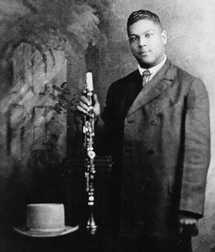jazz styles: by 1910 he was already working casually with regular bands. His earliest reputation was created by his playing there up to 1916, when he decided to travel and moved all over the South and Midwest, ending up in Chicago in 1917. There he played with transplanted New Orleans men such as King Oliver and Freddie Keppard, but his next permanent employment came from orchestra leader and composer Will Marion Cook, who hired him to be a member of his concert orchestra for a 1919 tour of Europe. Bechet, a nonreader, had been hired for his improvisatory skills and was featured in a blues which had European critics and musicians in raptures. Even geniuses have their problems, though, and although Bechet discovered the soprano saxophone with which he would be forever identified in London on this tour, and even played at Buckingham Palace, he was deported from England for a minor affray in 1922. Back in New York, in early 1923 he hitched up with businessman/musician Clarence Williams and recorded with Bessie Smith, later having duets with Louis Armstrong on the classic Clarence Williams Blue Five recordings for Okeh. He also played with Duke Ellington before returning to Europe, where in Paris he played for the Revue Negre. He also travled as far as Russia and Germany. Another affray, in Paris in 1929, led to a jail sentence. The following year, on his release, Bechet headed back to New York. He found the scene changed dramatically, and got work where he could, mainly with the Noble Sissle Orchestra, for whom he worked sporadically for man years. Having become something of a back number, Bechet managed some spirited “hot” sessions for Bluebird in 1932 featuring his trumpeter friend Tommy Ladnier, but the 1930s remained a lean time, and for a while Bechet ran a tailoring shop in Harlem. In 1939 he caught the crest of the gathering wave of enthusiasm for the classic jazz styles expressed by young white purists: his “Summertime,” cut for Blue Note that year, became a modest hit, and he took up regular work on 52nd Street with his pals such as Ladnier and the irrepressible Mezz Mezzrow. He made a series of classics for both Bluebird and Blue Note, including a famous session with Jelly Roll Morton and a legendary 1940 trio date with Earl Hines and Baby Dodds. He and Mezzrow also made series of immortal sides for Mezzrow’s King Jazz label. Bechet even managed a reunion on record with Armstrong, but prima donna antics between the two made it a muted affair. Bechet eventually found himself spending the latter part of the 1940s in isolation from the revivalist mainstream. His career was saved by a move to France in 1949, following a triumphant return to the Paris Festival of that year, where he’d even jammed with Charlie Parker and Miles Davis. Bechet used groups of enthusiastic young French traditionalists for musical support and enjoyed acclaim throughout Europe. Moving to Antibes in 1951 and marrying for a second time, Bechet eventually became something of a national hero, and after his death, from cancer in 1959, a large sculpted likeness was erected in Antibes. Nobody in New Orleans at the time had similar ideas musical selection:
0 Comments
Leave a Reply. |
Jazz LegendsA blog on the great legends in Jazz. Information via "The Encyclopedia of Jazz and Blues". Archives
December 2017
Categories |

 RSS Feed
RSS Feed

